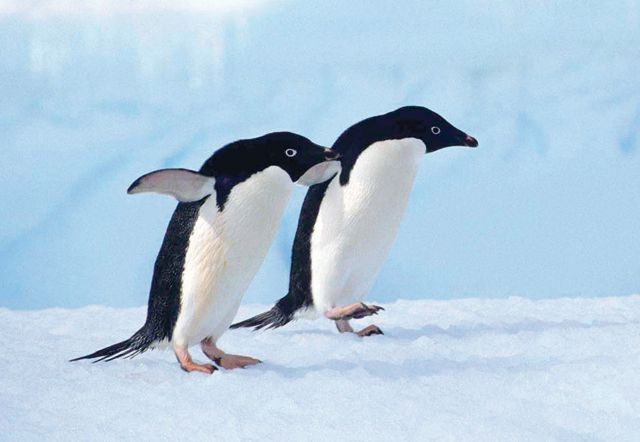It dawned with the warmest winter on record in the United States. And when the sun sets this New Year's Eve, the decade of the 2000s will end as the warmest ever on global temperature charts.
Warmer still, scientists say, lies ahead.
Through ten years of global boom and bust, of breakneck change around the planet, of terrorism, war and division, all people everywhere under that warming sun faced one threat together: the buildup of greenhouse gases, the rise in temperatures, the danger of a shifting climate, of drought, weather extremes and encroaching seas, of untold damage to the world humanity has created for itself over millennia.
As the decade neared its close, the United Nations gathered presidents and premiers of almost 100 nations for a "climate summit" to take united action, to sharply cut back the burning of coal and other fossil fuels.
Secretary-General Ban Ki-moon told them they had "a powerful opportunity to get on the right side of history" at the climate conference in Copenhagen.
Once again, however, disunity might keep the world's nations on this side of making historic decisions.
"Deep down, we know that you are not really listening," the Maldives' Mohammad Nasheed told fellow presidents at September's summit.
Nasheed's tiny homeland, a sprinkling of low-lying islands in the Indian Ocean, will be one of the earliest victims of seas rising from heat expansion and melting glaciers. On remote islets of Papua New Guinea, on Pacific atolls, on bleak Arctic shores, other coastal peoples in the 2000s were already making plans, packing up, seeking shelter.
The warming seas were growing more acid, too, from absorbing carbon dioxide, the biggest greenhouse gas in an overloaded atmosphere. Together, warmer waters and acidity will kill coral reefs and imperil other marine life — from plankton at the bottom of the food chain, to starfish and crabs, mussels and sea urchins.
Over the decade's first nine years, global temperatures averaged 0.6C higher than the 1951-1980 average, National Aeronautics and Space Administration (Nasa) reported. And temperatures rose faster in the far north than any place else on Earth.
The decade's final three summers melted Arctic sea ice more than ever before in modern times. Greenland's gargantuan ice cap was pouring 3 per cent more meltwater into the sea each year. Every summer's thaw reached deeper into the Arctic permafrost, threatening to unlock vast amounts of methane, a global-warming gas.
At the bottom of the world, late in the decade, International Polar Year research found that Antarctica, too, was warming. Floating ice shelves fringing its coast weakened, some breaking away, allowing the glaciers behind them to push ice faster into the rising oceans.
On six continents the glaciers retreated through the 2000s, shrinking future water sources for countless millions of Indians, Chinese and South Americans. The great lakes of Africa were shrinking, too, from higher temperatures, evaporation and drought. Across the temperate zones, flowers bloomed earlier, lakes froze later, bark beetles bored their destructive way northward through warmer forests. In the Arctic, surprised Eskimos spotted the red breasts of southern robins.
Worst case scenario
In the 2000s, all this was happening faster than anticipated, scientists said. So were other things: By late in the decade, global emissions of carbon dioxide matched the worst case among seven scenarios laid down in 2001 by the Intergovernmental Panel on Climate Change, the UN scientific network formed to peer into climate's future. By year-end 2008, the 2000s already included eight of the ten warmest years on record. By 2060, that trajectory could push temperatures a dangerous 4C or more higher than pre-industrial levels, British scientists said.
By 2009, with a new president and Congress, Washington seemed ready to talk. But in the front ranks of climate research — where they scale the glaciers, drill into ocean sediments, monitor a changing Earth through a web of satellite eyes — scientists feared they were running out of time.
Before the turn of the last century, with slide rule, pencil and months of tedious calculation, Svante Arrhenius was the first to show that carbon dioxide would warm the planet — in 3,000 years. The brilliant Swede hadn't foreseen the 20th-century explosion in use of fossil fuels.
Today their supercomputers tell his scientific heirs a much more urgent story: To halt and reverse that explosion of emissions, to head off a planetary climate crisis, the ten years that dawn this January 1 will be the fateful years, the final chance, the last decade.
The Nations
UNITED STATES:Offer to cut emissions by 17 per cent from 2005 levels by 2020, deepening to 30 per cent by 2025, 42 per cent by 2030 and 83 per cent by 2050.
RUSSIA:The government agreed to a cut of 20-25 per cent by 2020 from 1990 levels, raising its target from 15 per cent. This has not been confirmed officially.
CANADA:Sees a reduction of 20 per cent by 2020 compared with 2006, equivalent to a fall of 3 per cent compared with the 1990 benchmark.
CHINA:It will take voluntary steps to cut the intensity of its CO2 emissions per unit of GDP by 40 to 45 per cent by 2020 from 2005 levels.
JAPAN:Offers a cut of 25 per cent by 2020 relative to 1990, provided there is "a highly ambitious accord with participation by all major countries."
AUSTRALIA:Parliament has twice rejected a bill for reducing emissions by between 5 and 25 per cent by 2020 from 2000.
NORWAY:Says it is willing to reduce emissions by 30 per cent by 2020 over 1990 levels, and says it is willing to consider going to 30 or 40 per cent. Also aims to be carbon neutral by 2030.
BRAZIL:Voluntary reduction of 36-39 per cent by 2020, mainly from tackling deforestation in the Amazon, as compared to its forecast level of emissions in 2020.
INDIA:Plans to reduce level of ‘emission intensity' by 20 to 25 per cent by 2020. Says its per-capita emissions are very low and cuts have to be borne by rich countries.
MEXICO:Says it will propose slashing emissions by 50 per cent by 2050 so long as it receives international aid, and reduce emissions by 6 to 7 per cent by 2012.
Climate's decade in a nutshell
2001 - US President George W. Bush publicly rejects the 1997 Kyoto Protocol to rein in greenhouse gases.
2005 - After Russia's ratification, the Kyoto Protocol takes effect for 37 industrialised nations.
2005 - The year's average global temperatures are the highest in recorded history, Nasa reports.
2007 - The summer melt of Arctic sea ice is the greatest on record, the US National Snow and Ice Data Centre reports.
2007 - In its first assessment in six years, the UN scientific panel on climate projects temperatures may rise as much as 11.5 degrees Fahrenheit (6.4 degrees C) in the 21st century if nothing is done.
2009 - Focus falls on December's UN climate conference in Copenhagen as the arena for a new global agreement to combat warming.













